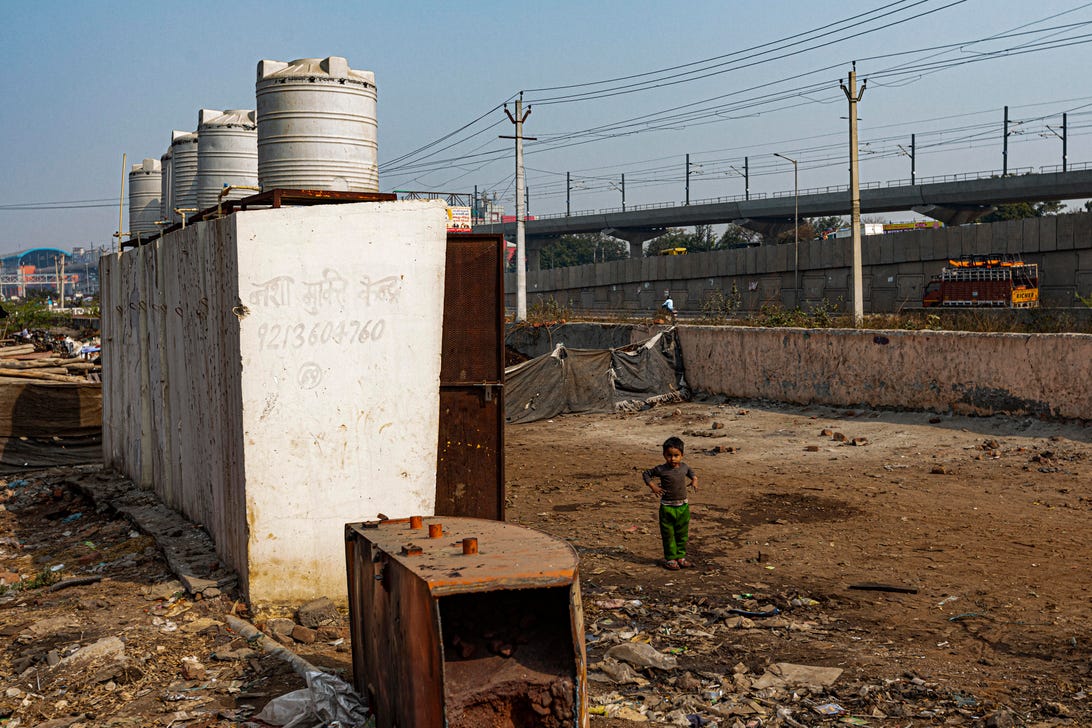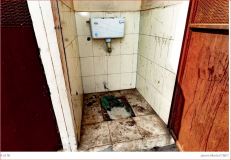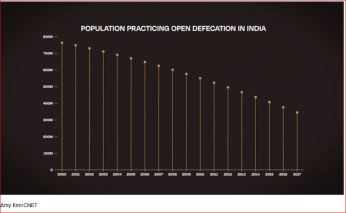.
“Studies have found that coronavirus can be spread through feces.…India is the No. 1 country in the world for open defecation, with over 344 million people without regular access to toilets...The actual number of toilets built is inflated. Households are given 12,000 rupees–about $160-to build a toilet, but Agarwal said the government rarely verifies that the toilets are constructed. Without verification, these funds are often pocketed by homeowners, village heads or construction companies….Or…shoddy toilets get built....Large chunks of Indian cities don’t have sewage lines.”
9/11/2020, “India spent $30 billion to fix its broken sanitation. It ended up with more problems,” cnet.com, Ben Fox Rubin, Suruchi Kapur-Gomes
“The Swachh Bharat [latrine building] mission, launched in 2014, was an ambitious effort to stop open defecation. It’s far from reaching that goal.

“Urmila is a housemaid living in a South Delhi slum….She’s grateful for not having to use a public toilet, though she admits that many prefer not using any toilet at all.
Meanwhile, Meera, who lives in a slum in New Delhi, prefers to defecate in the open, at nightfall….
[Image: Over 300 million in India defecate outside as of 2017]
That means hundreds of millions of people in the country end up defecating outside, which can spread diseases including cholera, typhoid and COVID-19. Poor sanitation in India leads to over 126,000 deaths every year from diarrheal diseases. Prime Minister Narendra Modi has sought to fix this longstanding issue through the Swachh Bharat, or Clean India, mission. A centerpiece program for his government, it started in 2014 as an effort to stop open defecation through promotion of better hygiene practices and the construction of millions of toilets [latrines, not connected to plumbing systems].
 While Modi essentially declared victory against open defecation in October 2019…the work of this program is far from over, particularly as the coronavirus pandemic rages in the country.
While Modi essentially declared victory against open defecation in October 2019…the work of this program is far from over, particularly as the coronavirus pandemic rages in the country.
Swachh Bharat [the latrine program] has made huge gains so far, but many challenges remain. Let’s run through them.
How does open defecation harm people’s health?
Fresh feces is filled with viruses and bacteria, able to transmit ailments including diarrhea, cholera, dysentery, hepatitis A, typhoid and polio. Transmission occurs when flying insects land on deposits and carry the viruses elsewhere or when excrement contaminates water supplies in groundwater or wells. Poor hygiene practices, like not washing hands after defecating, are common in poor and rural communities, making these areas especially susceptible to diseases.
“Kids are particularly vulnerable,” said Tom Slaymaker, a data specialist for UNICEF, who tracks sanitation and hygiene globally. He added that pathogens in fresh excrement are the biggest cause of diarrhea, and diarrhea is the biggest cause of death in children under the age of five globally.
Is the problem of open defecation getting better in India? Yes, it is, but there’s still a very long way to go.
 India is the No. 1 country in the world for open defecation, with over 344 million people without regular access to toilets in the country, according to 2017 statistics
from the World Health Organization and UNICEF. If you add up Nos. 2 to
10, it still wouldn’t come close to India’s number, showing just how big
the problem is there….
India is the No. 1 country in the world for open defecation, with over 344 million people without regular access to toilets in the country, according to 2017 statistics
from the World Health Organization and UNICEF. If you add up Nos. 2 to
10, it still wouldn’t come close to India’s number, showing just how big
the problem is there….
The number of people practicing open defecation was twice as high in 2000, at 764 million….
How did India become the No. 1 country for open defecation in the first place?
Overpopulation and a lack of sanitation infrastructure have contributed to this health crisis. Additionally, India has often failed to properly maintain public toilets after they’re built.
Cultural behaviors play a big role too. Purity is an inherent part of toilet etiquette in India. According to common customs, toilets are often built outside the home and deemed unclean. That means many people in India still see open defecation as a more sanitary option than using a bathroom in or near the home. Because of this, even after the government builds new toilets for people, they will go unused, instead functioning as storage rooms….
 (Image: “It’s evident that without proper attention and maintenance, toilets are at risk of being worse for community health than having nothing at all,” CNET)
(Image: “It’s evident that without proper attention and maintenance, toilets are at risk of being worse for community health than having nothing at all,” CNET)
Layered atop this cultural issue is a societal one. Lower castes for years had been tasked with cleaning latrines in India. While the caste system doesn’t hold the same sway it once did in the country, perceptions about lower castes being connected to toilets has put a negative light on sanitation.
How has Swachh Bharat worked to counteract these problems?
The central government has spent over $30 billion over the past seven years to improve sanitation across a country of 1.3 billion people. A primary part of this work has been building over 100 million toilets, especially in rural areas where open defecation has been much more widespread.
 While past sanitation efforts in India have focused mostly on building toilets, Swachh Bharat has included a much larger component of promotional campaigning, bringing in celebrities for ads and
putting Swachh Bharat posters around the country. The government is
also providing educational material to stigmatize open defecation and
change people’s behaviors so they use the new toilets.
While past sanitation efforts in India have focused mostly on building toilets, Swachh Bharat has included a much larger component of promotional campaigning, bringing in celebrities for ads and
putting Swachh Bharat posters around the country. The government is
also providing educational material to stigmatize open defecation and
change people’s behaviors so they use the new toilets.
India’s sanitation is broken, but there’s a plan to clean it up
A 2017 Bollywood film, Toilet: A Love Story, explored this mindset from the perspective of a village couple and a wife’s demand for a toilet. Film director Shree Narayan Singh wanted to send a message that a toilet doesn’t dirty a home, but open defecation does….
What are the challenges involved with this project?
There are a lot. Kabir Agarwal, a national reporter for news website The Wire in India, has been writing extensively about Swachh Bharat. He said the actual number of toilets built is inflated. Households are given 12,000 rupees — about $160 –– to build a toilet, but Agarwal said the government rarely verifies that the toilets are constructed.
Without verification, these funds are often pocketed by homeowners, village heads or construction companies, he said. Or as residents of a Faridabad slum told CNET, shoddy toilets get built and the builders keep more money for profit.
 In other cases, the task of maintaining the toilets after they’re built is never settled, so they quickly go into disrepair or are vandalized.
In other cases, the task of maintaining the toilets after they’re built is never settled, so they quickly go into disrepair or are vandalized.
“No one takes ownership of cleaning them,” Agarwal said....
Added to that, the work to bring wastewater to treatment plants and prevent it from contaminating water supplies will be a huge undertaking, partly because large chunks of Indian cities don’t have sewage lines, said Sushmita Sengupta, a program manager for the Centre for Science and Environment, a public advocacy and research group.
How has Swachh Bharat’s mission changed by coronavirus?
This project’s work, especially its focus on proper hygiene, has become even more critical during the coronavirus to help prevent more transmission of the disease. Studies have found that coronavirus can be spread through feces, so stopping wastewater from contaminating water supplies should help prevent the virus from spreading.
 But such progress has been limited: India is still experiencing a massive spike in coronavirus cases and deaths over the past few months….
But such progress has been limited: India is still experiencing a massive spike in coronavirus cases and deaths over the past few months….
Despite Swachh Bharat’s shortcomings, Modi in August lauded its progress in helping contain the virus....
Swachh Bharat officials didn’t reply to multiple requests for comment about these problems….In 2001, the nonprofit World Toilet Organization started World Toilet Day to raise awareness about the health risks of poor sanitation. The day is still marked every year on Nov. 19.
Swachh Bharat has inspired many new innovations, including Google Maps now showing people the locations of 57,000 public toilets around India. Several startups have been created to tackle the problem too. These firms include Garv Toilets, which builds tech-infused steel toilets that require less maintenance; Ekam, which developed odorless, waterless urinals; and Basic Shit, which makes low-cost portable toilets from recycled plastic bottles.
How has sanitation helped public health in the past?
During the European Dark Ages, cities were densely populated and had poor sanitation systems. People didn’t follow proper hygiene practices either. These factors contributed to people’s immune systems weakening and diseases spreading faster, especially during plague years. In London in the 1800s, after the River Thames was used to dump wastewater for centuries, the Great Stink overwhelmed the city and sparked the construction of a new sewage system….
Stench, death and disease from poor sanitation were virtually eradicated in developed countries. But, these problems persist in many developing nations, including India, Nigeria, Indonesia and Ethiopia.
What’s the future for Swachh Bharat? After Modi declared India open defecation-free last year, Swachh Bharat has pivoted its mission to something called ODF Plus, or open defecation free plus. The aim is to build on recent gains by working on waste management and reinforcing behavioral changes."...
…………………….
“Suruchi Kapur-Gomes is a senior editor and journalist based in Bangalore, India. She contributed research, reporting and translations for CNET’s A Dirty Job project about smart sanitation in India. She writes for the Sunday Guardian, among other publications.
.....................

No comments:
Post a Comment